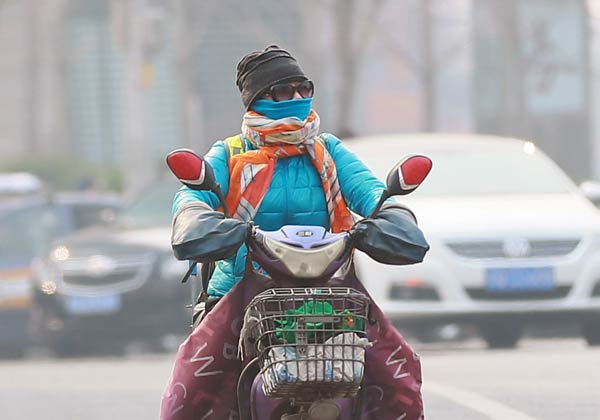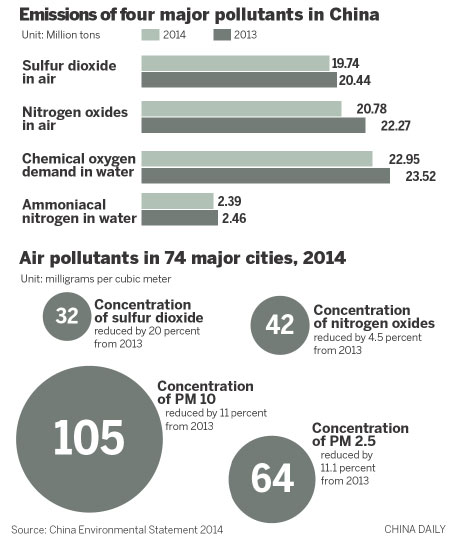 |
|
A mask-wearing resident rides an electric bike on the Dongzhimen Overpass in Beijing on Monday, March 24, 2014. The air quality index in the capital reached 320, indicating severe pollution. ZOU HONG / CHINA DAILY |
China's focus on the development of eco-civilization has met the annual targets for pollutant reduction and other progress in environmental protection, with improved air quality and more powerful supervision, according to an annual statement released by the Ministry of Environmental Protection on Thursday.
The statement said the levels of four major pollutants-sulfur dioxide and nitrogen oxides in the air, and chemical oxygen demand substances and ammoniacal nitrogen in water-have all been reduced year-on-year.
The greatest reduction was in nitrogen oxides at 6.7 percent. That was followed by reductions of 3.4 percent for sulfur dioxide, 2.9 percent for ammoniacal nitrogen and 2.47 percent for substances involving chemical oxygen demand.
With the decrease in pollutants, air quality has been improved. The concentration of PM2.5-air particles of 2.5 microns or less in diameter that can penetrate the lungs and harm health-has been reduced by 11.1 percent year-on-year in China's 74 major cities.
In the 161 cities that monitored PM2.5, 16 reached the national air quality standards.
Although the percentage of cities was low at about 10 percent, it was a big improvement over 2013, according to Xie Shaodong, professor of environmental studies at Peking University. Only three of the 74 cities reached the standard at that time, and only the 74 had the ability to monitor PM2.5.
"The improvement in air quality continues this year," he said, adding that government policies and stronger enforcement of environmental laws were the major factors behind the achievements.
Governments at all levels took comprehensive measures last year covering all aspects of pollution generation-industrial production, vehicle exhausts and other sources-the statement said.
They have controlled projects tightly to reduce pollution at source. The national environmental authority rejected 26 projects, whose total investment would have been 87.2 billion yuan ($14.1 billion). The air pollution monitoring network has covered 338 cities and counties, presenting the governments and public with a complete and timely picture on air quality, it said.
China has sifted out excessive or outdated production in polluting industries, eliminating 31.1 million tons of steel production capacity last year and more than 6 million vehicles with high exhaust emissions have been phased out, the statement said.
Emissions will continue to be reduced because of the strengthened laws and regulations, it said-a view shared by Xie and many environmental experts.
Since the revised Environmental Protection Law took effect on Jan 1, the legislation, which is regarded as the strictest version ever, and many regulations, have had an impact. The environmental authorities have inspected over 100,000 companies, and polluting ones were fined more than 2 billion yuan altogether.
The governments should continue to enforce the strict regulations and upgrade the economic structure to maintain the trend, Xie said.

